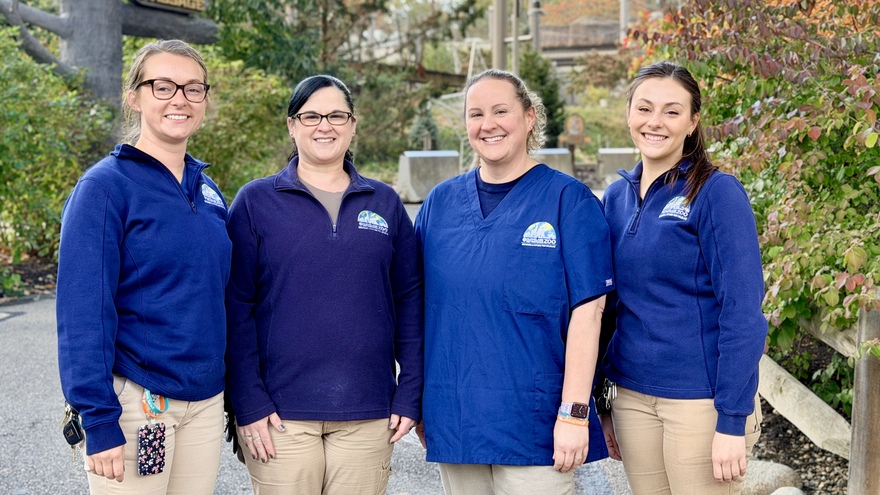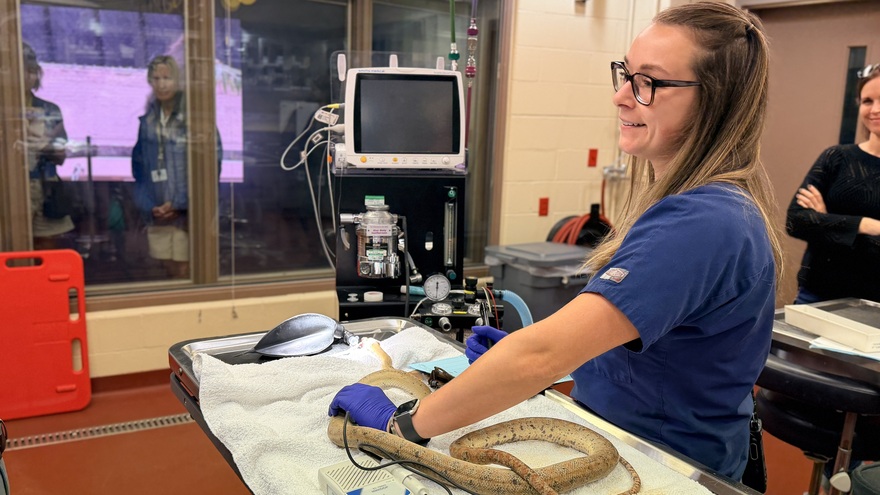A Day in the Life of a Zoo Veterinary Technician
Posted on Friday, October 24th, 2025
Assisting with a CT scan on a sloth in the morning and conducting voluntary, positive reinforcement training with a gorilla in the afternoon – it's just another day at the office for a veterinary technician at the Zoo.
With so many unique species and individual animals in their care, every day is a distinct challenge. Working collaboratively with Zoo veterinarians, animal keepers, and curators, veterinary technicians are on the front line of the Zoo’s nationally recognized animal care program.

Cleveland Metroparks Zoo's registered veterinary technicians (left to right): Taylor Borsz, Sharon Yahnert, Jenn Green, Autumn Gydosh
A typical day starts around 8:00 a.m. when the veterinary team meets at the scheduling board to go over the day’s exams, procedures, meetings, and other work items. From there, the vet techs usually prepare any medications needed for the day, then move on to their assigned tasks. This may mean participating in wellness examinations, surgical procedures, positive reinforcement training, and more.
Zoo News 2.0: A Day in the Life - Zoo Vet Tech
Most animals at the Zoo are on a triannual examination schedule, meaning they receive a comprehensive check-up every three years. Individuals that have chronic health issues or acute concerns are monitored more frequently. The positive reinforcement training conducted by keepers and veterinary technicians makes health care lower stress for the animals, who participate voluntarily in behaviors such as blood draws, pulse readings, EKGs, and more.
Veterinary technicians are central to some of this training as they perform many of these behaviors, so building a positive rapport with the animals is key. "It can be a challenge to work with all the species we do,” said Registered Veterinary Technician Taylor Borsz. “We collaborate with keepers and everyone in Animal Care to build relationships with these animals so they trust us. I’m really proud of the work we do to make their healthcare a positive experience.” Borsz is one of four veterinary technicians at the Zoo, whose combined experience in the field totals over 50 years.

Vet tech Taylor monitors the vitals of a boa
Surgical procedures may address minor issues such as dental extractions or more emergent injuries. A broad knowledge of species’ individualized needs is crucial to ensuring safe administration of anesthesia, monitoring vital signs, and navigating any challenges that arise.
The Sarah Allison Steffee Center for Zoological Medicine has a public viewing window into the veterinary treatment rooms – next time you visit, stop in to see if you can catch the veterinary technicians in action!


